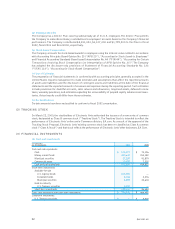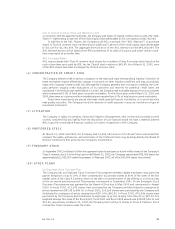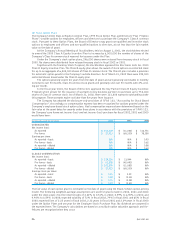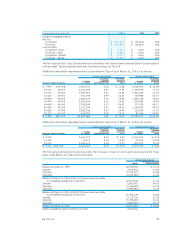Electronic Arts 2002 Annual Report Download - page 54
Download and view the complete annual report
Please find page 54 of the 2002 Electronic Arts annual report below. You can navigate through the pages in the report by either clicking on the pages listed below, or by using the keyword search tool below to find specific information within the annual report.
(l) Long-Lived Assets
The Company evaluates long-lived assets and certain identifiable intangibles for impairment whenever events
or changes in circumstances indicate that the carrying amount of an asset may not be recoverable. Recover-
ability of assets is measured by a comparison of the carrying amount of an asset to future undiscounted net
cash flows expected to be generated by the asset.This may include assumptions about future prospects for the
business that the asset relates to and typically involves computations of the estimated future cash flows to be
generated by these businesses. Based on these judgments and assumptions, the Company determines whether it
needs to take an impairment charge to reduce the value of the asset stated on the balance sheet to reflect its
actual fair value. Judgments and assumptions about future values and remaining useful lives are complex and
often subjective.They can be affected by a variety of factors, including but not limited to, significant negative
industry or economic trends, significant changes in the manner or the Company’s use of the acquired assets or
the strategy of the Company’s overall business and significant underperformance relative to expected historical
or projected future operating results. If such assets are considered to be impaired, the impairment to be recog-
nized is measured by the amount by which the carrying amount of the asset exceeds its fair value.
In April 2002, the Company adopted Statement of Financial Accounting Standards No. 144 (“SFAS
144”),
“Accounting for the Impairment or Disposal of Long-Lived Assets”
,which addresses financial
accounting and reporting for the impairment or disposal of long-lived assets.The Company is in the process
of determining the impact of this new accounting standard.The Company believes the implementation of
SFAS 144 will not have a material impact to its consolidated financial statements.
(m) Income Taxes
The Company uses the asset and liability method of accounting for income taxes. Under the asset and liabil-
ity method, the Company recognizes deferred tax assets and liabilities for the future tax consequences
attributable to differences between the financial statement carrying amounts and the tax basis of existing
assets and liabilities. Deferred tax assets and liabilities are based on temporary differences resulting from
differing treatment of items for tax and accounting purposes.The Company records a valuation allowance
to reduce tax assets to an amount whose realization is more likely than not.The valuation allowance is
based on the Company’s estimates of taxable income by jurisdiction in which the Company operates and the
period over which the Company’s deferred tax assets will be recoverable.
(n) Foreign Currency Translation
For each of the Company’s foreign subsidiaries the functional currency is its local currency. Assets and lia-
bilities of foreign operations are translated into U.S. dollars using current exchange rates, and revenues and
expenses are translated into U.S. dollars using average exchange rates.The effects of foreign currency trans-
lation adjustments are included as a component of accumulated other comprehensive income (loss) in
stockholders’ equity.
Foreign currency transaction gains and losses are a result of the effect of exchange rate changes on
transactions denominated in currencies other than the functional currency. Included in interest and other
income in the statements of operations are foreign currency transaction losses of $412,000, $888,000 and
$1,781,000, for the fiscal years ended March 31, 2002, 2001 and 2000, respectively.
On April 1, 2001, the Company adopted Statement of Financial Accounting Standards No. 133
(“SFAS 133”),
“Accounting for Derivative Instruments and Hedging Activities”
.SFAS 133 establishes
accounting and reporting standards for derivative instruments and hedging activities and requires us to rec-
ognize these as either assets or liabilities on the balance sheet and measure them at fair value. As described
in Note 3 of the Notes to Consolidated Financial Statements, gains and losses resulting from changes in fair
value are accounted for depending on the use of the derivative and whether it is designated and qualifies for
hedge accounting.The adoption of this accounting standard did not have a material impact on the Com-
pany’s consolidated financial position or results of operations.
(o) Net Income (Loss) Per Share
The following summarizes the computations of Basic Earnings Per Share (“EPS”) and Diluted EPS. Basic
EPS is computed as net earnings divided by the weighted-average number of common shares outstanding
for the period. Diluted EPS reflects the potential dilution that could occur from common shares issuable
through stock-based compensation plans including stock options, restricted stock awards, warrants and
other convertible securities using the treasury stock method.
Net income (loss) per share was calculated on a consolidated basis until Class A common stock and
Class B common stock were created as a result of the approval of the Tracking Stock Proposal (see Note 2 of
the Notes to Consolidated Financial Statements). Net income (loss) per share is computed individually for
Class A common stock and Class B common stock. Please see the discussion regarding segment reporting in
the Management’s Discussion and Analysis of Financial Condition and Results of Operations.
EA 2002 AR
50
























